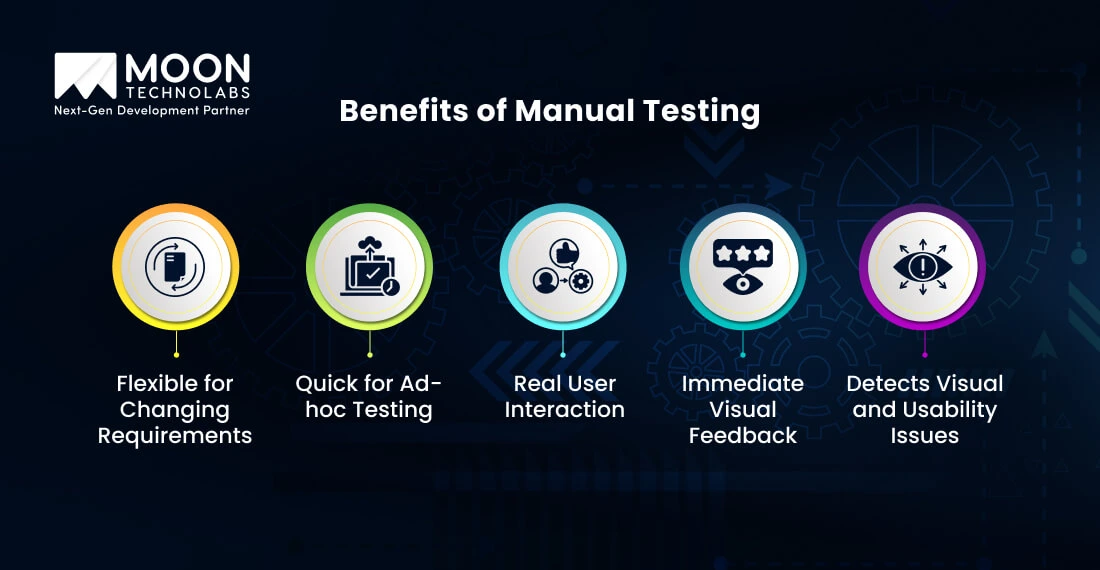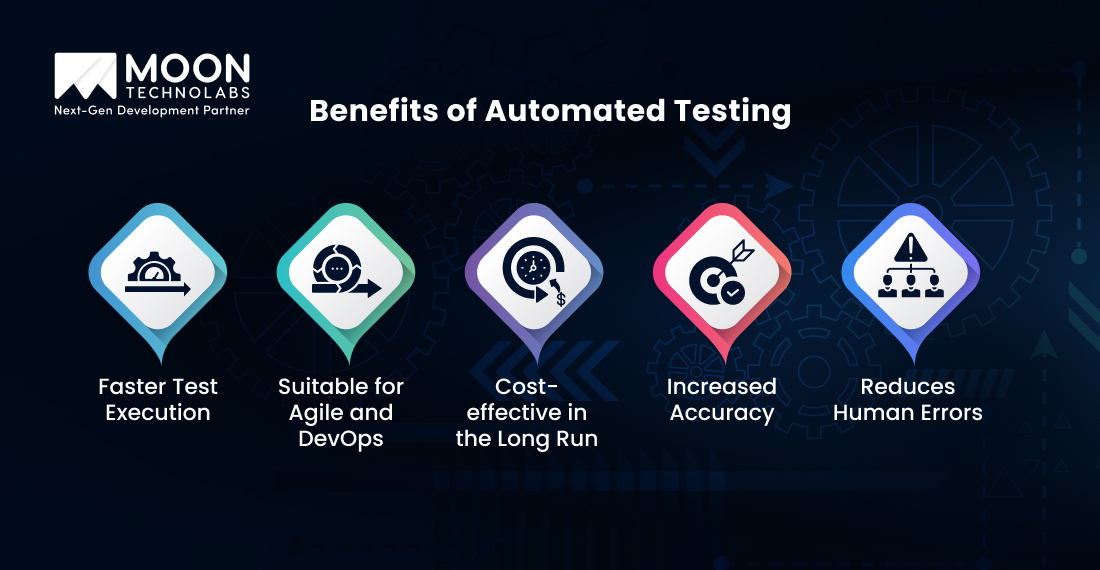Table of Content
Blog Summary:
Manual testing and automation testing are important types of software testing. So, which is the right option between these two? This blog answers the question. We explain key differences between these two. We also discuss details like the benefits, the right time to use, limitations, and challenges of these forms of testing.
Table of Content
Manual testing and automation testing are important types of software testing. So, which is the right option between these two? This blog answers the question. We explain key differences between these two. We also discuss details like the benefits, the right time to use, limitations, and challenges of these forms of testing.
Software development includes multiple steps – testing is one of those to ensure its quality. The testing market size has increased in recent years, especially with the increasing software development.
According to the Global Software Testing report, it’s likely to increase from USD 52.45 billion in 2024 to USD 57.46 billion in 2025 at a CAGR of 9.5%.

QA professionals often delve into detailed comparison of Manual Testing vs Automated Testing. The reason is both are popular forms of testing and have equal demand in the software realm for offering various pros and cons.
For instance, manual testing is flexible, adaptable, and requires less investment. But, it’s also time-consuming and prone to errors. On the other hand, automated testing offers higher accuracy and scalability. But, it requires huge initial cost and maintenance overhead.
So, which option can be right for your project? In this blog, we will explain everything. We will uncover the best option by describing the major differences between manual testing and automation testing.
Manual testing involves manually testing newly developed software rather than using automation tools. It includes numerous activities such as checking an app’s usability, functionality, and overall behavior from the user’s point of view.
In manual testing, QA experts need to follow a predefined set of test cases. They often rely on experience and intuition to recognize several issues, which are impossible to detect with automated testing.
Manual testing is quite beneficial, especially during the early stage of software development. With this testing, testers discover the possibility of adapting fast and thus ensure that the software behaves under real-world conditions.

Manual testing is quite beneficial, especially in those scenarios that require visual validation, flexibility, and user-centric approaches. The following are some of its top advantages:
Manual testing offers flexibility in dealing with changing requirements at the early stage of development. Testers easily and quickly adapt to these changes without the necessity to update or rewrite test scripts.
It can indeed be expensive and time-consuming. Therefore, manual testing is a perfect option for iterative development cycles where products evolve continuously.
Manual testing is perfect for ad-hoc scenarios where testers conduct spontaneous testing without any formal plan. For instance, it’s the best option, especially with limited documentation or when developers require fast feedback, be it for bug fixing or a new feature.
QA experts explore the application completely, finding bugs, etc. The speed and convenience of conducting these tests can indeed save time and effort.
For manual testing, testers need to use applications as real users. It helps them get a complete assessment of the software’s smooth and intuitive experience.
They can also use it to recognize certain frictions in the user flow, which gives them a complete understanding of how software behaves in real-world scenarios.
The human touch ensures the app matches user expectations, especially in many consumer-facing apps. In these apps, experience matters as much as functionality.
Manual testing provides quick visual feedback. It’s vital to validate various important elements, such as design, layout, font consistency, colors, and representativeness across multiple devices.
Manual testers discover visual misalignments or UI defects quickly, which many automated testing tools may overlook. This benefit is indeed important for software, where design and branding are vital, especially for mobile apps or e-commerce websites.
Manual testing is highly capable of detecting visual and usability issues that are not possible to capture through automation. This testing process allows for the detection of important elements such as overlapping text, button placement, broken images, and more.
Human judgment is important in usability testing because only they can fully assess whether a user journey makes sense or whether navigation is intuitive.
Manual testing is appropriate for different scenarios where real-time feedback, human intuition, and flexibility are necessary. Let’s explore various important situations when you need to opt for this testing.
Manual testing is always the right option for those projects with limited scope and tight deadlines. With this form of testing, testers start the process quickly, even without overhead scripting.
Ideal use case: It’s a perfect choice for a temporary project that requires fast validation.
Exploratory testing’s major goal is to learn about identifying edge cases and applications, uncover unexpected bugs, etc. This form of testing relies mainly on the tester’s domain expertise, creativity, intuitiveness, etc.
Ideal use case: Exploratory testing is an investigative and spontaneous choice for early-stage development of applications with many unfamiliar features.
Manual testing is important when assessing how end-users interact with the software. It enables you to find out whether an app is user-friendly, intuitive, and aligned perfectly with user expectations.
A tester has capability of determining users’ emotions, satisfaction, emotions, ease of use, etc. These are things that can’t be measured by any automation tool.
UI/UX testing often needs visual and sensory feedback, which only QA experts can provide. Manual testing ensures precise observation of color schemes, layout, alignment, fonts, responsiveness, and more.
Ideal Use Case: It’s specifically useful for catching various cosmetic issues and ensuring full consistency across multiple browsers and devices.
You Might Also Like:
Penetration Testing vs Vulnerability Scanning – What’s the Difference?
Automation testing is another important type of software testing. It involves using various specialized tools and scripts to execute many test cases of software applications without any human intervention.
It’s useful in verifying if software performs as expected by conducting time-consuming and repetitive tests more efficiently. Automation testing is beneficial in many large projects and agile environments where frequent code changes take place.
It opens up possibilities for enhanced accuracy, quick feedback, and consistent test outcomes. Some of the common types include performance, regression, load testing, etc.
By minimizing manual effort and maximizing test coverage, automation testing enables teams to emphasize more exploratory and complex testing tasks. It indeed boosts development speed and also software quality.

Since businesses seek to launch top-quality products quickly, automation testing provides an efficient and scalable solution that matches demands. We will discuss some of the other important advantages of automation testing below:
Automation testing offers faster test execution. In these, several test cases are required to be implemented across multiple devices and environments. It minimizes testing time and thus enables teams to match even tight release deadlines without compromising quality, which is important in many large-scale projects.
Automation testing ensures fast development cycles by facilitating frequent testing at every important development step. It integrates easily into CI/CD pipelines to offer fast feedback on code changes.
It assists the team in detecting and fixing bugs earlier during the process, leading to quick iterations and more trusted software releases.
The initial investment in automation tools and script development can be higher. However, it proves worthwhile over time since it minimizes the necessity for repeated manual effort.
Automation testing saves significant resources for long-term projects with contentious updates.
Automation testing removes inconsistencies caused by human fatigue or oversight that occur with manual testing. Test scripts actually perform the same steps every time they run.
It ensures both reliable and consistent outcomes. This accuracy is highly important, especially when dealing with various complex test cases or scenarios that need exact validations.
Manual testing leads to several errors when it comes to complex or repetitive test cases. Automation minimizes the overall risk by implementing predefined scripts even without deviation. It minimizes the chances of missing bugs or generating false outcomes due to oversight, which boosts the reliability of the testing process.
Not sure which testing strategy is right for your project? We help you strike the perfect balance between manual precision and automation speed.
Automation testing is appropriate for situations where accuracy, speed, and repeatability are pivotal. It facilitates teams’ maintaining quality software while saving time and effort.
The following are situations where automation testing is the right option to go with:
For code changes, it’s necessary to ensure existing functionality remains intact. Automation testing ensures consistent and efficient regression testing.
Automated test scripts tend to rerun as often as required, which makes it convenient to identify any issues introduced by several new changes.
Automation testing minimizes the need for large QA teams to execute various repetitive tasks manually. After creating test scripts, teams can reuse them across multiple builds and environments with less human intervention.
This is beneficial in agile or startup environments where manpower and time are constrained.
Security is important in any application, specifically those that handle sensitive data. Automation ensures thorough and complete security testing by using tools that simulate several attack scenarios.
It ensures the detection and resolution of vulnerabilities. It’s also useful in protecting user data and maintaining compliance with industry standards.
Automation is important to simulate large numbers of virtual users and determine how the applications handle higher traffic or vast amounts of data. Automation load testing detects performance issues, whereas stress testing defines the system’s breaking point.
Manual testing explores the edges; automation checks the routine highways.🎯
Though manual and automation testing serve the same purpose, they are different in terms of their operations and various other factors. We have presented the major differences between these two through a table:
| Points of Difference | Manual Testing | Automated Testing |
|---|---|---|
| Execution | Human testers perform manual testing. | It’s possible through automation tools. |
| Consistency | It causes various human errors. | It’s indeed consistent once scripts are written correctly and with higher accuracy. |
| Flexibility | It’s indeed adaptable to the changing requirements. | It’s less flexible and needs script updates for changes. |
| Cost | It’s less expensive. But it can be quite expensive in the long run. | It requires a huge investment. But it can be cost-efficient for a long time. |
| Performance Testing | It’s not suitable for stress or load testing and performance. | It’s appropriate for load testing and performance. |
| Set Up | It requires less setup. | It needs environment tools, setup, and frameworks. |
| Parallel Execution | Manual testing doesn’t include the possibility of parallel execution. | Automated testing supports parallel execution for faster outcomes. |
| Framework | It doesn’t require any specific framework. | It requires fully structured frameworks. |
| Specialization Areas | Its specialization areas include exploratory, usability, ad-hoc testing, etc. | Its specialization areas include load, regression, and security testing. |
| Turnaround Time | Manual testing requires a long turnaround time. | Its turnaround time is indeed fast due to automation. |
| Results Coverage | Manual testing includes limited coverage in less time. | It includes high coverage with improved reporting. |
| Test Design | Manual testing includes exploratory and dynamic testing. | Automated testing is predefined and scripted. |
Automation testing is more efficient, speedy, and reliable than manual testing. It allows testers to implement repetitive test cases quickly, which makes it great for:
Though initial setup may be expensive, automation is quite affordable with time due to reusable test scripts and minimized manual effort. It also supports parallel testing, enhances coverage, and allows quick product release with improved quality.
Manual testing is available with a set of advantages and disadvantages that directly impact higher efficiency and effectiveness. Let’s explore some of the limitations and challenges in depth:
The main disadvantage of manual testing is inconsistency in its overall outcomes. It relies only on human intervention and requires huge efforts. Testers get the flexibility to interpret test cases differently, which leads to varied results.
It also impacts testing quality because humans work for a long time, causing fatigue and minimizing reliability. Hence, it’s quite challenging to guarantee that the same test generates identical outcomes across different runs or testers.
Manual testing is indeed slower than its counterpart. As mentioned, it relies heavily on human interference and requires testers to implement every test case. This process is time-consuming for large applications with several features.
The time that manual testing takes maximizes the overall development cycle. It delays developer feedback and prolongs time to market. The slower pace can become problematic in DevOps or Agile, which necessitates rapid iterations.
In addition, testing repetitive tasks, including regression tests, becomes tough, leading to test burnout and further delays.
Manual testing often results in less test coverage, especially compared to automated testing. When testers perform several tests manually, they are limited in terms of the number of test cases they can implement within the provided time frame.
Manual testing focuses mainly on important parts and also those of many high-priority areas, avoiding edge cases or various less frequent scenarios. It minimizes coverage, increases vulnerabilities and undetected bugs, specifically for complex apps.
When it comes to coverage, manual testing is different from automated testing in terms of scalability, leaving potential weaknesses in software undiscovered.
Manual testing provides numerous advantages over automated testing in situations involving human judgment and flexibility. It’s perfectly suited for:
Automated testing is available with several advantages. Meanwhile, it’s also available with various shortcomings as well. We will discuss various limitations and challenges in detail:
Automated testing is less flexible and is perfect for many repetitive and various predictable tasks, including regression testing. However, it’s less suitable for exploratory testing or cases where requirements change frequently.
Automated testing can adapt to various new conditions, changes in functionality, and UI. However, it is time-consuming and requires a higher level of maintenance.
Since automation testing is less flexible, it’s less effective for projects with many dynamic and emerging requirements.
The initial setup cost of automated testing is expensive. Maintaining automated test scripts requires a huge investment in skilled personnel and tools. Besides, automated testing tools are quite expensive to buy.
Integrating these tools into a development environment requires effort, time, and training. Writing and maintaining test scripts is often mandatory for testers and developers with extensive knowledge of programming languages and automation frameworks. So, the up-front investment is a huge challenge for several projects or many smaller teams that have tight budgets.
Automated testing often lacks human intervention. Manual testers detect potential issues based on their experience. They may identify many usability issues or UX issues that are impossible for any automated script to detect.
Automated tests are rule-based and fully structured, which minimizes their capability of discovering issues that require human judgment.
They focus mainly on verifying whether the software behaves according to specifications. However, they are less effective at determining how user-friendly or intuitive an interface is.
We offer tailored manual and automation testing services to ensure high-quality, bug-free software delivery at speed and scale.
Whether it’s automation or manual testing, it plays an indispensable role in providing quality software. As we discussed, manual testing is right for usability, exploratory, and short-term projects.
On the other hand, automation testing is good for accuracy, speed, and scalability for repetitive tasks. So, the selection between these two relies on various factors like budget, project requirements, timelines, and more.
At Moon Technolabs, we specialize in conducting manual and automated testing services. We are a leading software testing company, always ready to assist businesses in adopting a perfectly balanced approach for the highest efficiency, coverage, and user satisfaction throughout the development lifecycle.
01
02
03
04
Submitting the form below will ensure a prompt response from us.